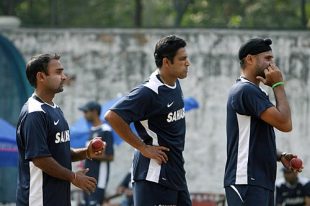India spinning into a crisis?
It's up to Harbhajan Singh and Amit Mishra to prove that they can at least partially fill the breach left by Anil Kumble's retirement
Dileep Premachandran
17-Dec-2008

| ||
How much do India miss Anil Kumble? At the risk of inviting irate reactions from the old romantics, more than they've ever missed any other bowler. In home conditions, Kumble was in a class of his own. Bishan Bedi, Bhagwat Chandrasekhar and Erapalli Prasanna don't even come close, and Harbhajan Singh must reinvent himself drastically if he's to have anything like the same impact in the second half of his career.
So much has been written about Monty Panesar's travails in India that the performances of Harbhajan and Amit Mishra in Chennai have slipped under the radar. Michael Atherton pointed them out in a typically astute column in the Times, and it's worth remembering just how comfortably Andrew Strauss and Paul Collingwood played Harbhajan from deep inside the crease. It's far too early to make an assessment of Mishra's qualities, but Harbhajan is bound to come under the scanner now that he's the senior spin bowler in the side.
To analyse his career, it's necessary to break it into two significant portions. Having made his debut in 1998, he only established himself in the side after the 32-wicket heroics against Steve Waugh's team in 2001. Kumble was recuperating from shoulder surgery at the time, but from that point on, it was Harbhajan that was the frontline spinner until he faced finger surgery of his own after the Gabba Test of 2003.
Kumble, who got his chance in the next game in Adelaide, didn't waste it, and Harbhajan was once again back to support-spinner status when he returned against Australia in October 2004. Though he enjoyed a fine series with 21 wickets, it was Kumble who grabbed the headlines, especially on the opening day in Chennai where he took 7 for 48.
Before that finger injury in 2003, Harbhajan's home record was superior even to Kumble, though it's not necessarily fair to compare 18 Tests with 63. Over the 63 games he played in India, Kumble took a staggering 350 wickets at 24.88 and a strike-rate of 59.4. Of the golden oldies, Bedi had the best average [23.99, albeit at a strike-rate of 75.8], while Chandrasekhar had the best strike-rate [64.6]. Kumble's own figures were inflated during the course of a wretched final year, when a succession of injuries restricted him to just seven wickets at considerable cost from four Tests.
Prior to his injury, Harbhajan had taken 96 wickets at 23.33 from 18 Tests. The strike-rate [56.2] too was in the Kumble category. Since returning though, he hasn't been anything like as effective. The 23 Tests since October 2004 have seen him take 114 wickets at 29.78, and a strike-rate of 64.5. The only ten-wicket hauls were against Australia [2004, in a match India lost heavily in Bangalore] and Sri Lanka [Ahmedabad 2005]. Too often, the five-wicket hauls have been meaningless ones, with teams throwing the bat around after raising huge totals.
So, what has changed? The pitches, undoubtedly. The rank turners that Kumble had so much success on in the mid-1990s are largely a thing of the past, and when they do make an appearance [Mumbai 2004 and Kanpur 2008], visiting teams invariably run off crying to the ICC. But blaming the pitches alone would be a cop-out, a failure to admit that Indian spin is in crisis.
| Murali Kartik is highly rated on the county circuit, but that opinion doesn't seem to be shared by India's selectors, despite 22 wickets at 25.77 in his six home Tests | |||
Atherton summed up Harbhajan's predicament perfectly in his column. "I am not entirely sure that Harbhajan is the bowler he used to be, now that an overextended use of the doosra - the ball that spins to the off - has affected his ability to drift and spin his stock ball, the offspinner," he wrote. It's something other commentators have been saying for years, and was best illustrated in Sri Lanka a few months ago, when Ajantha Mendis and Muttiah Muralitharan made India's spinners look second-rate.
Both Harbhajan and Mishra will undoubtedly play in Mohali. Just two months ago, they took 12 wickets between them as Australia were routed. It's worth pointing out though that whenever Mahendra Singh Dhoni wants to keep the runs down or take a crucial wicket, it's the pace bowlers and reverse-swing that he turns to. Even in Chennai, it was mainly Ishant Sharma and Zaheer Khan that reduced England to a fourth-day crawl, with Ishant summoning a superb spell to dismiss Andrew Flintoff.
So, what are India's options when it comes to spin? Not very many. Piyush Chawla did nothing in his two Tests, and Pragyan Ojha is just as unproven. Murali Kartik is highly rated on the county circuit, but that opinion doesn't seem to be shared by India's selectors, despite 22 wickets at 25.77 in his six home Tests.
With quite a few pace options waiting in the wings - Munaf Patel and a fit-again Sreesanth would definitely add value to the side - it's not unthinkable India will soon go the Australian way. For the best part of 15 years, they played mainly three fast bowlers alongside Shane Warne. Sadly for India, there's no Warne on the horizon, and it's up to Harbhajan and Mishra to prove that they can at least partially fill the breach left by Kumble's retirement.
Dileep Premachandran is an associate editor at Cricinfo